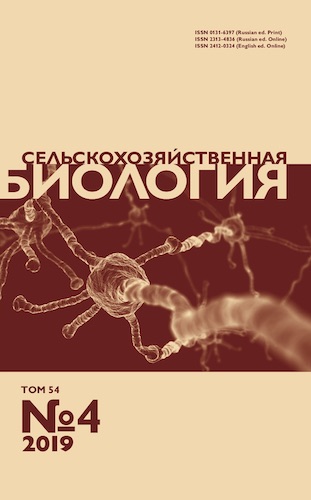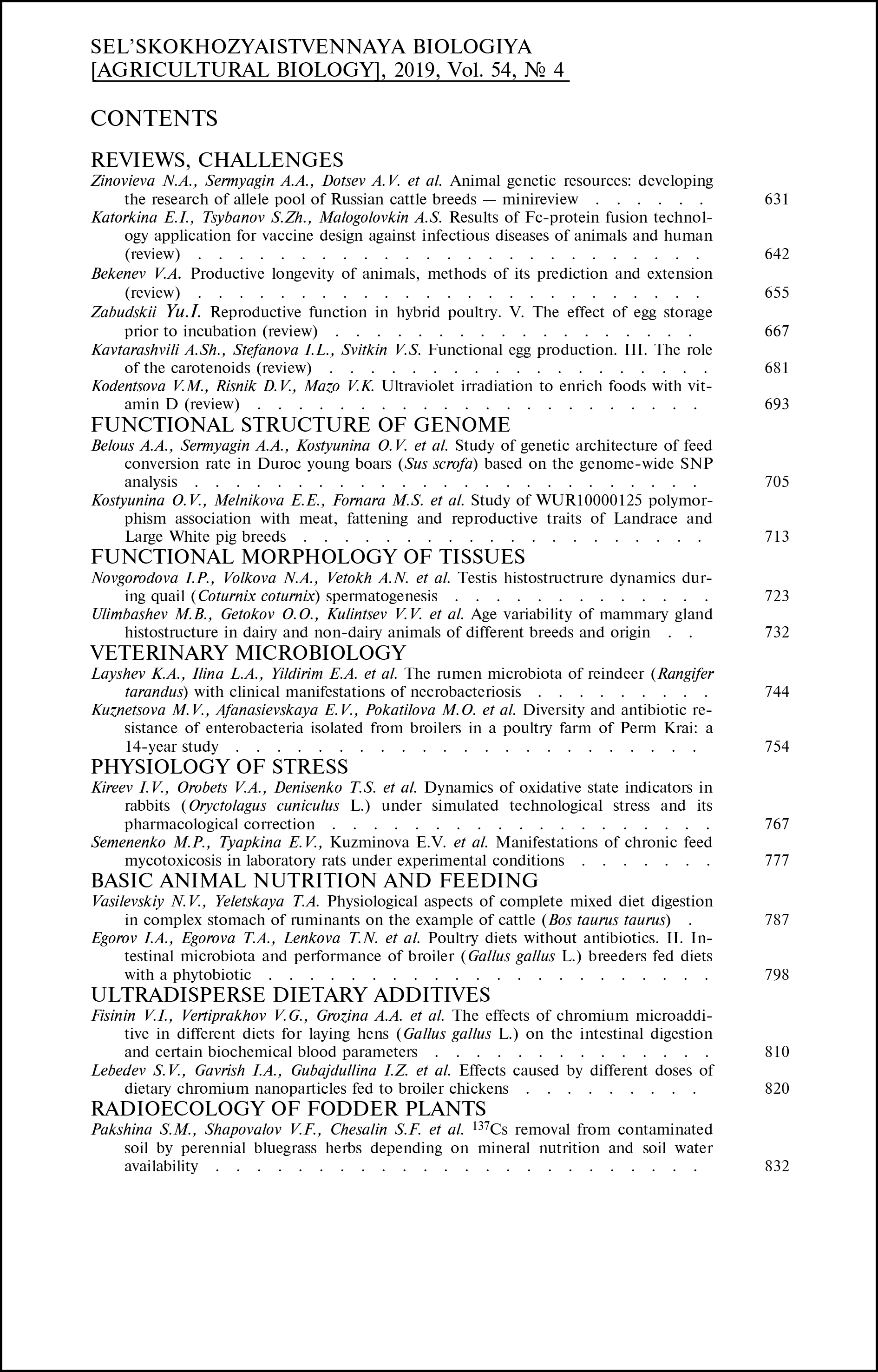doi: 10.15389/agrobiology.2019.4.767eng
UDC: 636.92:619:591.1:616-092.9
DYNAMICS OF OXIDATIVE STATE INDICATORS IN RABBITS (Oryctolagus cuniculus L.) UNDER SIMULATED TECHNOLOGICAL STRESS AND ITS PHARMACOLOGICAL CORRECTION
I.V. Kireev, V.A. Orobets, Т.S. Denisenko, D.A. Zinchenko
Stavropol State Agrarian University, 12, per. Zootechnicheskii, Stavropol,355017 Russia, e-mail kireev-iv@mail.ru (✉ corresponding author), orobets@yandex.ru, chernova_ts@mail.ru, zinchenko444@mail
ORCID:
Kireev I.V. orcid.org/0000-0003-0723-4515
Denisenko Т.S. orcid.org/0000-0002-6185-9199
Orobets V.A. orcid.org/0000-0002-4774-263X
Zinchenko D.A. orcid.org/0000-0001-8674-5449
Received August 6, 2018
Stress is the most important livestock problem, causing great damage to the industry. The emergence of technological stress contributes to a large number of factors, from transportation to conditions of keeping and feeding. The development of pathological processes under stress intensifies free radical processes in the body, with the excessive formation of free radicals. Therefore, there is a need in drugs based on substances with high antioxidant activity to pharmacologically correct technological stress in farm animals. In our experiment, we simulated conditions of technological stress in Soviet chinchilla rabbits aged 6-7 months by immobilization. Antioxidant and anti-stress drugs developed at Stavropol State Agrarian University were used as agents. Group 1 of animals was control. Rabbits of group 2 received Drug to correct stress in farm animals (Patent RU 2428992 of 09.20.11), group 3 received Mebisel (Patent RU 2418579 of 05.20.11), these drugs have a pronounced anti-stress effect; group 4 received Antioxidant preparation for animals (Patent RU 2435572 of 12.10.11) and group 5 received Polyoxidol (Patent RU 2538666 of 01.10.15), the antioxidants. Blood levels of cortisol, thyroxine, lipid peroxidation and antioxidant protection were assessed. It was shown that immobilization of experimental animals provokes a significant production of cortisol (5,8 times higher) and a decrease in the thyroxine level up to 60,9 % (p ≤ 0,01), the blood concentration of diene conjugates increases 2.6 times (p ≤ 0,01), malondialdehyde by 55,8 % (p ≤ 0,01) and fluorescent Schiff bases 2,2 times (p ≤ 0,01). The restricted mobility adversely affectes the activity of antioxidative defence enzymes, with a significant decrease in glutathione peroxidase activity (by 35.2 %), superoxide dismutase (by 36.4 %), catalase (by 40.7 %) (p ≤ 0.01) and the content of reduced glutathione (by 33.3 %, p ≤ 0.01). Administration of antioxidant and antistress preparations contributes to the normalization of the studied parameters in experimental animals, the values of which during the experiment were statistically significantly different from the data recorded in the control group. In the dynamics of activity of antioxidant enzymes and products of lipid peroxidation, there were significant differences between the indices of animals from the control group and rabbits which received preventive agents. The animals of the control group showed a progressive increase in the concentration of lipoperoxides and a decrease in the activity of glutathione peroxidase, superoxide dismutase, catalase, and reduced glutathione. The use of antioxidant and antistress drugs three days before immobilization contributed to the optimization of these indicators. The applied prevention regimens allowed reduction of negative impact of stress, which resulted in statistically significant differences in the numerical values of the results of the laboratory blood test of animals from the groups 2, 3, 4 and 5 conoared to the control. At the end of the experiment glutathione peroxidase was 48.2-107.4 % higher (p ≤ 0.01), superoxide dismutase 31.1-85.9 % higher (p ≤ 0.01), catalase 12.9-40.1 % higher (p ≤ 0.05 in groups III, IV and V), while glutathione was 34.8-60.8 % lower (p ≤ 0.01), thyroxine 27.2-82.7 % lower (p ≤ 0.05). The cortisol level declined by 83.5-207.0 % (p ≤ 0.01), diene conjugates by 37.2-84.3 % (p £ 0.01), malondialdehyde by 26.1-46.9 % (p ≤ 0.05), and fluorescent Schiff bases by 22.03-118.1 % (p ≤ 0.05). The use of drugs accelerates post-stress adaptation, which was expressed in an increase in the average daily weight gain of rabbits from experimental groups, i.e. 28 g for group 2, 34 g for group 3, 36 g for group 4, and 38 g for group 5 compared to 24 g for the control group. Our results on the stress-born hormone dynamics are indicative of significant changes in the antioxidant defense system functioning and lipid peroxidation. These data allow us to recommend the developed tranquilizers and antioxidants for physiological correction of technological stresses in animals.
Keywords: Oryctolagus cuniculus L., rabbits, technological stress, immobilization, antistress agent, antioxidant preparation, antioxidant system, lipid peroxidation, hormones, enzymes.
REFERENCES
- Pertsov S.S., Kalinichenko L.S., Koplik E.V., Nagler L.G., Alinkina E.S., Kozachenko A.I. Biomeditsinskaya khimiya, 2015, 61(3): 394-399 CrossRef (in Russ.).
- Chen H.J., Spiers J.G., Sernia C., Anderson S.T., Lavidis N.A. Reactive nitrogen species contribute to the rapid onset of redox changes induced by acute immobilization stress in rats. Stress, 2014, 17(6): 520-527 CrossRef
- Hall J.A., Bobe G., Nixon B.K., Vorachek W.R., Hugejiletu, Nichols T., Mosher W.D., Pirelli G.J. Effect of transport on blood selenium and glutathione status in feeder lambs. Journal of Animal Science, 2014, 92(9): 4115-4122 CrossRef
- Teixeira R.R., de Souza A.V., Peixoto L.G., Machado H.L., Caixeta D.C., Vilela D.D., Baptista N.B., Franci C.R., Espindola F.S. Royal jelly decreases corticosterone levels and improves the brain antioxidant system in restraint and cold stressed rats. Neuroscience Letters, 2017, 655: 179-185 CrossRef
- Veremei E.I., Rukol' V.M., Zhurba V.A., Komarovskii V.A., Khovailo V.A. Uchenye zapiski uchrezhdeniya obrazovaniya Vitebskaya ordena «Znak pocheta» gosudarstvennaya akademiya veterinarnoi meditsiny, 2011, 47(2): 143 (in Russ.).
- Megahed G.A., Anwar M.M., Wasfy S.I., Hammadeh M.E. Influence of heat stress on the cortisol and oxidant-antioxidants balance during oestrous phase in buffalo-cows (Bubalus bubalis): thermo-protective role of antioxidant treatment. Reproduction in Domestic Animals, 2008, 43(6): 672-677 CrossRef
- Sejian V., Maurya V.P., Naqvi S.M. Effect of thermal stress, restricted feeding and combined stresses (thermal stress and restricted feeding) on growth and plasma reproductive hormone levels of Malpura ewes under semi-arid tropical environment. Journal of Animal Physiology and Animal Nutrition, 2011, 95(2): 252-258 CrossRef
- Abd El-Hack M.E., Khafaga A.F., Arif M., Taha A.E., Noreldin A.E. Stress biomarkers and proteomics alteration to thermal stress in ruminants: a review. Journal of Thermal Biology, 2019, 79: 120-134 CrossRef
- Smid A.C., Weary D.M., Bokkers E.A.M., von Keyserlingk M.A.G. Short communication: The effects of regrouping in relation to fresh feed delivery in lactating Holstein cows. Journal of Dairy Science, 2019, 102 (7): 6545-6550 CrossRef
- Souza-Cácares M.B., Fialho A.L.L., Silva W.A.L., Cardoso C.J.T., Pöhland R., Martins M.I.M., Melo-Sterza F.A. Oocyte quality and heat shock proteins in oocytes from bovine breeds adapted to the tropics under different conditions of environmental thermal stress. Theriogenology, 2019, 130: 103-110 CrossRef
- Malašauskienė D., Televičius M., Juozaitienė V., Antanaitis R. Rumination time as an indicator of stress in the first thirty days after calving. Polish Journal of Veterinary Sciences, 2019, 22(2): 363-368 CrossRef
- Nagel C., Aurich C., Aurich J. Stress effects on the regulation of parturition in different domestic animal species. Animal Reproduction Science, 2019, 207: 153-161 CrossRef
- Lushchak V.I. Free radicals, reactive oxygen species, oxidative stress and its classification. Chemico-Biological Interactions, 2014, 224: 164-175 CrossRef
- Vikram D.S., Rivera B.K., Kuppusamy P. In vivo imaging of free radicals and oxygen. Methods in Molecular Biology, 2010, 610: 3-27 CrossRef
- Nikitina E.V., Romanova N.K. Vestnik Kazanskogo tekhnologicheskogo universiteta, 2010, 10: 375-381 (in Russ.).
- Iannitti T., Rottigni V., Palmieri B. Role of free radicals and antioxidant defences in oral cavity-related pathologies. Journal of Oral Pathology & Medicine, 2012, 41(9): 649-661 CrossRef
- Pratt D.A., Tallman K.A., Porter N.A. Free radical oxidation of polyunsaturated lipids: new mechanistic insights and the development of peroxyl radical clocks. Accounts of Chemical Research, 2011, 44(6): 458-467 CrossRef
- Meshchaninov V.N., Shcherbakov D.L. Kazanskii meditsinskii zhurnal, 2015, 96(5): 843-849 CrossRef
- Flerov M.A., V'yushina A.V. Rossiiskii fiziologicheskii zhurnal im. I.M. Sechenova, 2011, 97(9): 898-902 (in Russ.).
- Lyapin O.A., Lyapina V.O. Izvestiya Orenburgskogo gosudarstvennogo agrarnogo universiteta, 2016, 2(58): 161-165 (in Russ.).
- Dobson H., Fergani C., Routly J.E., Smith R.F. Effects of stress on reproduction in ewes. Animal Reproduction Science, 2012, 130(3-4): 135-140 CrossRef
- Ekiz B., Ekiz E.E., Kocak O., Yalcintan H., Yilmaz A. Effect of pre-slaughter management regarding transportation and time in lairage on certain stress parameters, carcass and meat quality characteristics in Kivircik lambs. Meat Science, 2012, 90(4): 967-976 CrossRef
- Kireev I.V., Orobets V.A., Skripkin V.S., Kovalev P.F. Preparat dlya korrektsii stressovykh sostoyanii u sel'skokhozyaistvennykh zhivotnykh. Pat. 2428992 (RF) MPK9 A 61 K 33/04, A 61 K 33/00, A 61 P 25/00. FGOU VPO Stavropol'skii GAU (RF). № 2010139029/15. Zayavl. 22.09.2010. Opubl. 20.09.2011. Byul. № 26 [Stress correcting medication for farm animals.Patent 2428992 (RF) MPK9 A 61 K 33/04, A 61 K 33/00, A 61 P 25/00. FGOU VPO Stavropol'skii GAU (RF). № 2010139029/15. Appl. 22.09.2010. Publ. 20.09.2011. Bul. № 26] (in Russ.).
- Orobets V.A., Aksenov A.V., Aksenova I.V., Kireev I.V., Skripkin V.S., Belyaev V.A., Sevost'yanova O.I., Lavrenchuk E.I. Immunostimuliruyushchii preparat dlya normalizatsii obmena selena i korrektsii stressovykh sostoyanii dlya sel'skokhozyaistvennykh zhivotnykh. Pat. 2418579 (RF) MPK9 A 61 K 31/095, A 61 P 43/00. FGOU VPO Stavropol'skii GAU (RF). № 2010117696/15. Zayavl. 04.05.2010. Opubl. 20.05.2011. Byul. № 14 [Immunostimulating medication to normalize selenium metabolism and correct effects of stress in farm animals. Patent 2418579 (RF) MPK9 A 61 K 31/095, A 61 P 43/00. FGOU VPO Stavropol'skii GAU (RF). № 2010117696/15. Appl. 04.05.2010. Publ. 20.05.2011. Bul. № 14] (in Russ.).
- Kireev I.V., Orobets V.A., Skripkin V.S., Kovalev P.F. Antioksidantnyi preparat dlya zhivotnykh. Pat. 2435572 (RF) MPK9 A 61 K 31/00,A 61 P 39/06. FGOU VPO Stavropol'skii GAU (RF). № 2010143411/15. Zayavl. 22.10.2010. Opubl. 10.12.2011. Byul. № 34 [The antioxidant for animals. Patent 2435572 (RF) MPK9 A 61 K 31/00, A 61 P 39/06. FGOU VPO Stavropol'skii GAU (RF). № 2010143411/15. Appl. 22.10.2010. Publ. 10.12.2011. Bul. № 34] (in Russ.).
- Kireev I.V., Orobets V.A., Belyaev V.A., Serov A.V., Skripkin V.S., Verevkina M.N., Chernova T.S., Rakovskaya E.V. Preparat dlya normalizatsii protsessov perekisnogo okisleniya lipidov u zhivotnykh. Pat. 2538666 (RF) MPK9 A 61 K 31/4412, A 61 K 31/375, A 61 K 33/04, A 61 P 3/00. OOO NPO «Yug-Biovet». № 2013111243/15. Zayavl. 12.03.13. Opubl. 10.01.15. Byul. № 1 [The remedy to normalize lipid peroxidation in animals. Patent 2538666 (RF) MPK9 A 61 K 31/4412, A 61 K 31/375, A 61 K 33/04, A 61 P 3/00. OOO NPO «Yug-Biovet». № 2013111243/15. Appl. 12.03.13. Publ. 10.01.15. Bul. № 1] (in Russ.).
- Retskii M.I., Shabunin S.V., Bliznetsova G.N., Rogacheva T.E., Ermolova T.G., Fomenko O.Yu., Bratchenko E.V., Dubovtsev V.Yu., Kaverin N.N., Tsebrzhinskii O.I. Metodicheskie polozheniya po izucheniyu protsessov svobodnoradikal'nogo okisleniya i sistemy antioksidantnoi zashchity organizma [The methodology for studying free radical oxidation processes and antioxidant defense system]. Voronezh, 2010 (in Russ.).
- Colpo A.C., de Lima M.E., Maya-López M., Rosa H., Márquez-Curiel C., Galván-Arzate S., Santamaría A., Folmer V. Compounds from Ilex paraguariensis extracts have antioxidant effects in the brains of rats subjected to chronic immobilization stress. Applied Physiology, Nutrition, and Metabolism, 2017, 42(11): 1172-1178 CrossRef
- Koptev M.M., Vynnyk N.I. Morphological substantiation for acute immobilization stress-related disorders of adaptation mechanisms. Wiadomosci Lekarskie, 2017, 70(4): 767-770.
- Kumar A., Goyal R., Prakash A. Possible GABAergic mechanism in the protective effect of allopregnenolone against immobilization stress. European Journal of Pharmacology, 2009, 602(2-3): 343-347 CrossRef
- Samarghandian S., Samini F., Azimi-Nezhad M., Farkhondeh T. Anti-oxidative effects of safranal on immobilization-induced oxidative damage in rat brain. Neuroscience Letters, 2017, 659: 26-32 CrossRef
- Dickinson D.A., Forman H.J. Glutathione in defense and signaling: lessons from a small thiol. Annals of the New York Academy of Sciences, 2002, 973: 488-504 CrossRef
- Forman H.J., Zhang H., Rinna A. Glutathione: overview of its protective roles, measurement, and biosynthesis. Molecular Aspects of Medicine, 2009, 30 (1-2): 1-12 CrossRef
- Hepel M., Stobiecka M. Supramolecular interactions of oxidative stress biomarker glutathione with fluorone black. Spectrochimica Acta Part A: Molecular and Biomolecular Spectroscopy, 2018, 192: 146-152 CrossRef
- Teskey G., Abrahem R., Cao R., Gyurjian K., Islamoglu H., Lucero M., Martinez A., Paredes E., Salaiz O., Robinson B., Venketaraman V. Glutathione as a marker for human disease. Advances in Clinical Chemistry, 2018, 87: 141-159 CrossRef












